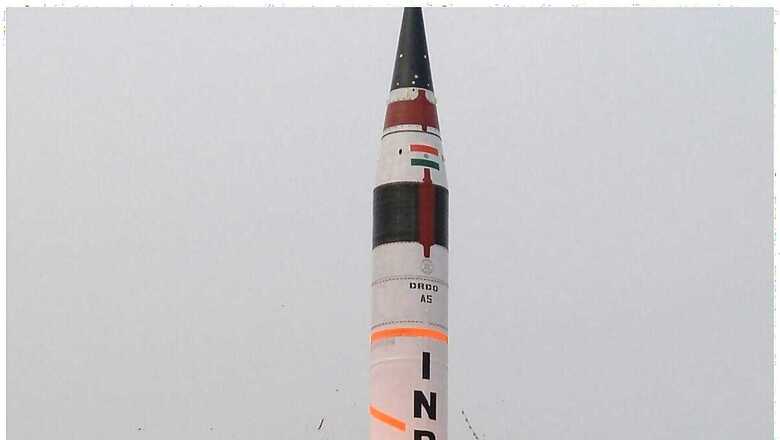
views
In a significant development in India’s nuclear prowess, New Delhi tested the first flight test of an indigenously developed Agni-5 missile with Multiple Independently Targetable Re-entry Vehicle (MIRV) technology. The announcement, made by Prime Minister Narendra Modi via the widely used social media platform ‘X’ (formerly Twitter), heralded India’s entry into the exclusive league of nations possessing MIRV capability.
The milestone launch was conducted as part of “Mission Divyastra,” a crucial facet of DRDO’s Guided Missile Development Project, Agni. The Agni series of missiles has been a cornerstone of India’s defence arsenal since the early 1990s, and this latest development comes under the indigenously developed Agni-5 series of missiles.
The announcement marks a significant bolstering of India’s defence capabilities, fundamentally reshaping the regional power dynamics. With persistent challenges emanating from various fronts, and neighbouring countries like Pakistan and China, this advancement strengthens India’s position in the realm of nuclear deterrence.
Understanding MIRV and its Importance for India
MIRV stands for Multiple Independently Targetable Re-entry Vehicles. Originating in the 1960s, MIRV technology was developed to enhance the effectiveness of missile strikes by enabling the delivery of multiple nuclear warheads to different locations. This technology allows a single missile to carry multiple warheads including nuclear warheads, each capable of being aimed at a different target, thereby ensuring that a single missile can deploy multiple warheads at diverse sets of locations.
Equipped with indigenous Avionics systems and high-precision sensor packages, the Agni-5 ensures that its re-entry vehicles reach their designated targets with exceptional accuracy. Now that India has indigenously developed MIRV technology, it is a part of elite countries like the US, the UK, France, China, and Russia, which possess this technology.
Analysts believe that while the shorter-range Agni-I and II primarily targeted traditional rival Pakistan, the subsequent versions, boasting extended ranges, signal India’s strategic pivot towards addressing potential threats from China.
The MIRV technology was initially developed by the United States, which produced a MIRV Intercontinental Ballistic Missile (ICBM) in 1970 and a ballistic missile launched from a submarine the following year. A submarine-launched ballistic missile (SLBM) and an intercontinental ballistic missile (ICBM) equipped with MIRV capability were later developed by the then Soviet Union.
What sets the MIRV system apart is that, unlike conventional missiles that carry a single warhead, Multiple Independently Targetable Re-entry Vehicles (MIRVs) possess the capacity to deliver multiple warheads. These warheads can be deployed at varying speeds and trajectories, enabling strikes on targets spanning distances of up to 1,500 kilometres. Land-based MIRV missiles, in particular, are deemed notably destabilising.
The utilisation of MIRVed missiles on submarines substantially enhances their survivability, as nuclear submarines are notoriously challenging to detect. Consequently, India’s acquisition of this capability is, thus, an enunciator of India’s burgeoning technological prowess and fortifies its strategic deterrence posture.
According to strategic analyst Brahma Chellaney, the incorporation of MIRVs in the Agni-5 enhances India’s capacity for a second-strike capability against China, which has been actively expanding its nuclear arsenal. Experts assert that India’s pursuit of MIRV technology is motivated, in part, by the imperative to surmount Chinese ballistic missile defence systems, as MIRVs possess the ability to circumvent such defence through the deployment of multiple genuine or decoy warheads. Moreover, MIRV technology offers the tactical advantage of multiple targeting options, enhancing cost-effectiveness by enabling a single missile to engage multiple tactical and strategic targets. Furthermore, the development of critical new weapon systems will likely strengthen India’s position in future arms control negotiations.
However, India’s strides in nuclear advancement have not been universally lauded. Hans Kristensen, Director of the Nuclear Information Project at the Federation of American Scientists, expressed reservations regarding India’s test of MIRV-equipped missiles, cautioning that operationalising MIRV capability could enable India to target more objectives with fewer missiles, potentially escalating nuclear tensions.
Conversely, Indian scholars contend that MIRV technology reinforces India’s adherence to the principle of no-first-use, as possessing credible missile systems capable of evading missile defence mitigates concerns regarding a “use them or lose them” scenario. In this regard, the acquisition of MIRV capability bolsters India’s nuclear deterrence posture, aligning with its longstanding policy of exercising restraint in nuclear matters.
If a country wants to ensure the efficacy of deterrence, it must first have the ability to inflict substantial damage on its adversaries. Without such capacity, deterrence loses its effectiveness, indicating a lack of strength, or worse, cowardice.
Since its landmark Pokhran-II tests in 1998, India has consistently demonstrated responsible nuclear stewardship, underscored by its unequivocal commitment to a “no first use” policy. It has consistently shown great restraint during very provoking situations over the decades. China and India are currently the only two nuclear powers to formally maintain a no first use policy, adopting pledges in 1964 and 1998 respectively.
Thus, amidst escalating regional tensions, India’s adoption of MIRV technology should be contextualized within the broader framework of maintaining strategic stability and should not be seen as a destabilising development in the sensitive region it is situated in.
Esha Banerji is presently associated with a premier think-tank in India, specialising in defence, security, and strategic studies. Her research interest and focuses of analysis are defence strategy, geo-economics, foreign affairs, and the implications of Chinese security developments on the region, especially India. Views expressed in the above piece are personal and solely that of the author. They do not necessarily reflect News18’s views.

















Comments
0 comment